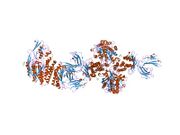Biology:Transferrin receptor 1
 Generic protein structure example |
Transferrin receptor protein 1 (TfR1), also known as Cluster of Differentiation 71 (CD71), is a protein that in humans is encoded by the TFRC gene.[1][2] TfR1 is required for iron import from transferrin into cells by endocytosis.[3][4]
Structure and function

TfR1 is a transmembrane glycoprotein composed of two disulfide-linked monomers joined by two disulfide bonds. Each monomer binds one holo-transferrin molecule creating an iron-Tf-TfR complex which enters the cell by endocytosis.[5]
Clinical significance
TfR1 as a potential new target in cases of human leukemia & lymphoma. InatherYs, in Évry, France, developed a candidate drug, INA01 antibody (anti-CD71) that showed efficacy in pre-clinical studies in the therapy of two incurable orphan oncohematological diseases: the adult T cell leukemia (ATLL) caused by HTLV-1 and the Mantle cell lymphoma (MCL).[citation needed]
TfR1 expressed on the endothelial cells of the blood-brain barrier (BBB) is used also in preclinical research to allow the delivery of large molecules including antibodies into the brain.[6] Some of the TfR1 targeting antibodies have been shown to cross the blood-brain barrier, without interfering with the uptake of iron. Amongst those are the mouse anti rat-TfR antibody OX26[7] and the rat anti mouse-TfR antibody 8D3.[8] The affinity of the antibody-TfR interaction seems to be important determining the success of transcytotic transport over endothelial cells of the BBB. Monovalent TfR interaction favors BBB transport due to altered intracellular sorting pathways. Avidity effects of bivalent interactions redirecting transport to the lysosome.[9] Also, reducing TfR binding affinity directly promote dissociation from the TfR which increase brain parenchymal exposure of the TfR binding antibody.[10]
Interactions
TfR1 has been shown to interact with GABARAP[11] and HFE.[12][13]
Immunostain marker
CD71 is a robust immunohistochemistry marker for chorionic villi, especially in necrotic specimens. Among white blood cells and precursors, CD71 is expressed only by erythroid precursors within the normal hematopoietic marrow and spleen, in contrast to glycophorin that marks all types of red blood cells.[14]
See also
- Transferrin receptor 2
- Cluster of differentiation
References
- ↑ "Ubiquitous cell-surface glycoprotein on tumor cells is proliferation-associated receptor for transferrin". Proceedings of the National Academy of Sciences of the United States of America 78 (7): 4515–9. July 1981. doi:10.1073/pnas.78.7.4515. PMID 6270680. Bibcode: 1981PNAS...78.4515S.
- ↑ "Regional localization of the human transferrin receptor gene to 3q26.2----qter". American Journal of Human Genetics 37 (6): 1112–6. November 1985. PMID 3002171.
- ↑ "Transferrin receptor 1". The International Journal of Biochemistry & Cell Biology 36 (11): 2137–43. November 2004. doi:10.1016/j.biocel.2004.02.007. PMID 15313461.
- ↑ "Brain iron homeostasis". Danish Medical Bulletin 49 (4): 279–301. November 2002. PMID 12553165.
- ↑ "Biological and clinical aspects of soluble transferrin receptor". Critical Reviews in Clinical Laboratory Sciences 47 (5–6): 213–28. December 2010. doi:10.3109/10408363.2010.550461. PMID 21391831.
- ↑ "Targeting the transferrin receptor for brain drug delivery". Progress in Neurobiology 181: 101665. October 2019. doi:10.1016/j.pneurobio.2019.101665. PMID 31376426. https://vbn.aau.dk/ws/files/308691033/1_s2.0_S0301008219301340_main.pdf.
- ↑ "Selective transport of an anti-transferrin receptor antibody through the blood-brain barrier in vivo". The Journal of Pharmacology and Experimental Therapeutics 259 (1): 66–70. October 1991. PMID 1920136.
- ↑ "Targeting rat anti-mouse transferrin receptor monoclonal antibodies through blood-brain barrier in mouse". The Journal of Pharmacology and Experimental Therapeutics 292 (3): 1048–52. March 2000. PMID 10688622.
- ↑ "Increased brain penetration and potency of a therapeutic antibody using a monovalent molecular shuttle". Neuron 81 (1): 49–60. January 2014. doi:10.1016/j.neuron.2013.10.061. PMID 24411731.
- ↑ "Boosting brain uptake of a therapeutic antibody by reducing its affinity for a transcytosis target". Science Translational Medicine 3 (84): 84ra44. May 2011. doi:10.1126/scitranslmed.3002230. PMID 21613623.
- ↑ "Association of human transferrin receptor with GABARAP". FEBS Letters 518 (1–3): 101–6. May 2002. doi:10.1016/S0014-5793(02)02655-8. PMID 11997026. https://escholarship.org/content/qt75g9j0p1/qt75g9j0p1.pdf?t=ntzy5g.
- ↑ "The hemochromatosis gene product complexes with the transferrin receptor and lowers its affinity for ligand binding". Proceedings of the National Academy of Sciences of the United States of America 95 (4): 1472–7. February 1998. doi:10.1073/pnas.95.4.1472. PMID 9465039. Bibcode: 1998PNAS...95.1472F.
- ↑ "Comparison of the interactions of transferrin receptor and transferrin receptor 2 with transferrin and the hereditary hemochromatosis protein HFE". The Journal of Biological Chemistry 275 (49): 38135–8. December 2000. doi:10.1074/jbc.C000664200. PMID 11027676.
- ↑ "CD71". 14 May 2021. https://www.pathologyoutlines.com/topic/cdmarkerscd71.html.
External links
- Overview of all the structural information available in the PDB for UniProt: P02786 (Human Transferrin receptor protein 1) at the PDBe-KB.
 |





